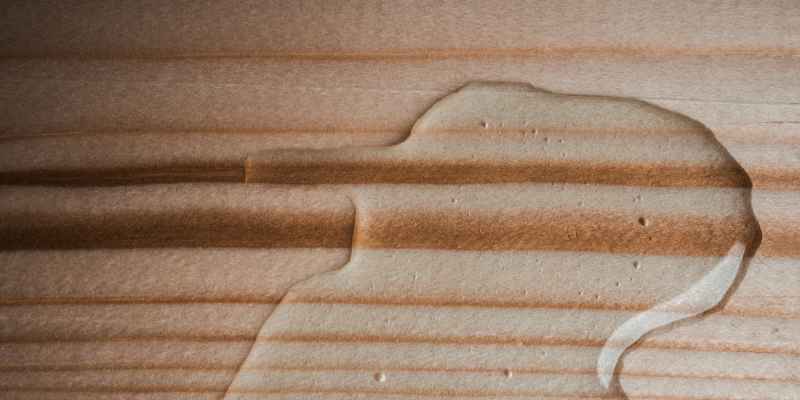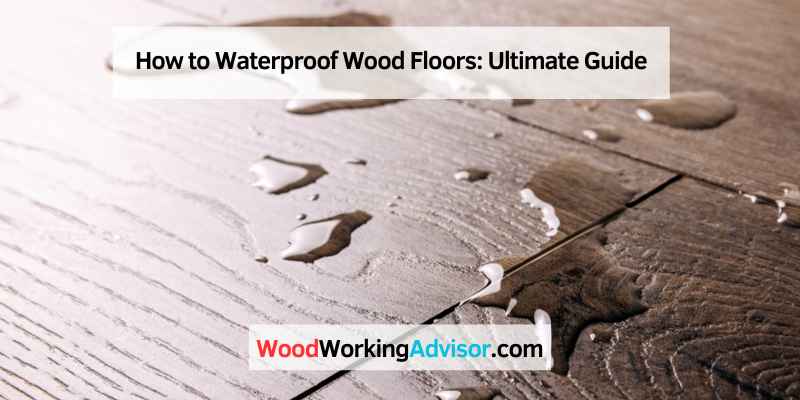To waterproof wood floors, invest in a high-quality finish such as polyurethane or wax that is compatible with your type of hardwood flooring for maximum protection. Spread the finish using a wool mop instead of a paint roller for better results.
In addition to this, ensure that the floor is properly cleaned and dried before applying the finish. Regularly inspect your plumbing, control the humidity in your home, and clean up spills immediately to prevent water damage. Use high-quality hardwood floor products and consider using a sealant like WOCA Woodcare to provide extra protection.
Hardwood floors are a popular choice for many homeowners due to their natural beauty and durability. However, one downside is that they are not inherently waterproof. Without proper protection, wood floors can easily get damaged by water and moisture, leading to warping, staining, and even mold growth.
Thankfully, there are steps you can take to waterproof your wood floors and ensure their longevity and beauty. We will explore different methods and tips for effectively waterproofing wood floors, from choosing the right finish to implementing preventative measures. By following these guidelines, you can enjoy your wood floors worry-free, even in environments prone to water exposure.
Understanding Waterproofing
To ensure the longevity of wood floors, understanding waterproofing is essential. Protect the wood from water damage by investing in a high-quality finish, such as polyurethane or wax, to create a sealant that prevents moisture from seeping in. Regularly inspecting plumbing and using high-quality hardwood floor products can also enhance water resistance.
How Waterproofing Protects Wood Floors
When it comes to protecting your wood floors from water damage, waterproofing is the key. Understanding how waterproofing works can help you choose the right products and methods to ensure the longevity of your floors. Waterproofing creates a barrier that prevents water and moisture from seeping into the wood, which can cause warping, swelling, and rotting. By applying a protective layer to the surface of the wood, you can enhance its resistance to water and keep your floors looking beautiful for years to come.
Different Types Of Waterproofing Products
There are several types of waterproofing products available in the market, each designed to cater to specific needs and preferences. It’s important to understand the different options so that you can make an informed decision.
| Type | Description |
|---|---|
| Waterproof Sealants | These sealants are applied directly to the wood surface and create a protective barrier. They are available in various formulas, such as oil-based or water-based, and offer different levels of durability and shine. Waterproof sealants are easy to apply and can provide long-lasting protection against water damage. |
| Waterproof Coatings | These coatings are usually applied as a topcoat over the wood floor finish. They create a durable and waterproof layer that acts as a shield against water and moisture. Waterproof coatings are available in different finishes, including glossy, semi-glossy, and matte, allowing you to choose the look that best suits your aesthetic preferences. |
| Waterproof Membranes | Waterproof membranes are sheets or rolls that are applied beneath the wood floor. They act as a barrier against moisture that might come from the subfloor or the environment. These membranes offer excellent protection against water damage and are commonly used in areas prone to moisture, such as basements or bathrooms. |
With these different types of waterproofing products available, you can choose the one that suits your specific needs, budget, and preferences. However, it’s important to note that proper application and maintenance are essential for optimal results.
By understanding how waterproofing protects wood floors and exploring the different types of waterproofing products, you can take the necessary steps to safeguard your floors against water damage. With the right waterproofing solution in place, you can enjoy the beauty and durability of your wood floors for years to come.
Preparing For Waterproofing
To waterproof wood floors effectively, start by selecting a high-quality finish like polyurethane or wax. Apply the finish to create a protective sealant that prevents moisture damage. Choose a wool mop for even application and durability, ensuring long-lasting waterproof protection.
Assessing Wood Floor Condition
Examine your wood floors for any signs of damage, such as cracks or warping, to ensure they are in good condition before waterproofing.
Cleaning And Sanding The Surface
Clean the wood surface using a gentle wood cleaner to remove dirt and grime. Sanding the surface lightly helps the waterproofing sealant adhere better.
Methods Of Waterproofing
When it comes to safeguarding your wood floors from water damage, several effective methods of waterproofing exist. Understanding these methods can help you maintain the beauty and durability of your wooden flooring. Let’s explore the different techniques for waterproofing wood floors.
Surface Sealants And Topical Treatments
Surface sealants and topical treatments create a protective layer on the surface of the wood, preventing water penetration. These are easy to apply and provide a barrier against spills and moisture, ensuring longevity for your floors.
Penetrating Oils And Sealants
Penetrating oils and sealants work by soaking into the wood fibers, enhancing their water resistance from within. These products are ideal for maintaining the natural look of wood while effectively repelling liquids.
Moisture Barrier Underlayment
Moisture barrier underlayment is a waterproofing solution installed beneath the wood flooring. It acts as a shield against moisture rising from the subfloor, safeguarding your wood floors from water damage.
DIY Vs. Professional Services

Looking for ways to waterproof wood floors? You can choose between DIY methods or professional services. DIY methods may be cost-effective, but professional services offer expertise and long-lasting results. Deciding which option to choose depends on your budget and the level of waterproofing you need.
Pros And Cons Of Diy Waterproofing
Many homeowners may consider DIY waterproofing as a cost-effective solution for their wood floors. However, it is important to weigh the pros and cons before undertaking this task.
Pros
- Cost savings: DIY waterproofing can save money on labor costs associated with hiring professionals.
- Flexibility: You have the freedom to choose the materials and methods that suit your preferences and budget.
- Learning experience: DIY projects allow you to acquire new skills and knowledge about wood floor maintenance.
Cons
- Limited expertise: Unless you have experience in waterproofing, you may not achieve the same level of effectiveness as professional services.
- Time-consuming: DIY projects can be time-consuming, especially if you are not familiar with the process.
- Potential mistakes: Inadequate preparation or the wrong choice of materials can lead to mistakes that may compromise the waterproofing quality.
- Lack of warranties: DIY waterproofing may not come with warranties or guarantees compared to professional services.
Benefits Of Professional Waterproofing Services
While DIY waterproofing has its advantages, professional waterproofing services offer numerous benefits that may outweigh the DIY approach.
Time-saving
Professional services can complete the waterproofing process more efficiently, saving you valuable time and effort. They have the necessary tools, equipment, and experience to get the job done quickly and effectively.
Expertise and Skills
Professionals specialize in wood floor waterproofing and have extensive knowledge of different techniques and materials. They can provide expert advice and recommendations tailored to your specific needs.
High-Quality Results
Professional waterproofing services ensure superior results and long-lasting protection for your wood floors. They use high-quality products and follow industry best practices to deliver a waterproofing solution that exceeds DIY standards.
Warranty and Guarantee
Most professional waterproofing services offer warranties or guarantees for their work. This provides peace of mind and protection in case of any issues in the future.
In conclusion, while DIY waterproofing may seem appealing for its cost savings and flexibility, professional waterproofing services offer numerous benefits such as time-saving, expertise, high-quality results, and warranties.
Maintaining Waterproofed Wood Floors
To waterproof wood floors, invest in a high-quality finish, such as polyurethane, to seal and protect the wood from water damage. Regularly inspect plumbing and control humidity to avoid water damage. Clean up spills immediately and use high-quality hardwood floor products to maintain water resistance.
After waterproofing your wood floors, it is essential to maintain the waterproofing to ensure the longevity and durability of the wood. Proper maintenance will help to protect your investment and keep your floors looking their best for years to come.
Regular Cleaning And Inspections
Regular cleaning and inspections are crucial for maintaining waterproofed wood floors. Use a damp mop or a specific wood floor cleaner to remove dust, dirt, and any spills. Additionally, perform regular visual inspections to check for any signs of wear, damage, or areas where waterproofing may need reapplication.
Reapplication Of Waterproofing Products
To maintain the waterproofing of your wood floors, consider reapplying waterproofing products as needed. This may involve using specific wood sealants or coatings to reinforce the waterproofing barrier and protect the wood from moisture damage.
Frequently Asked Questions Of How To Waterproof Wood Floors
How Do You Permanently Waterproof Wood?
To permanently waterproof wood, apply a high-quality finish like polyurethane or wax compatible with the wood type. This creates a sealant to prevent moisture seepage.
How Can I Make My Floor Waterproof?
Waterproof your floor by applying a high-quality finish like polyurethane or wax to prevent water damage.
How Do I Protect My Hardwood Floors From Water?
To protect hardwood floors from water, follow these steps: 1. Control humidity levels in your home. 2. Regularly inspect plumbing for leaks. 3. Clean up spills immediately. 4. Use high-quality hardwood floor products. 5. Apply a high-quality finish like polyurethane or wax compatible with your hardwood flooring.
How Do You Seal Wood Floors From Water?
To seal wood floors from water, apply a high-quality finish like polyurethane or wax that forms a protective barrier against moisture. This prevents water damage by stopping moisture from penetrating the wood. Make sure the finish is suitable for your hardwood flooring type.
Conclusion
To ensure the longevity and durability of your wood floors, it is essential to waterproof them. By investing in a high-quality finish, such as polyurethane or wax, you can create a protective sealant that prevents moisture from penetrating the wood.
Additionally, using a moisture barrier underlayment can further safeguard your floors from potential damage. Remember to clean up spills promptly and control the humidity in your home to maintain the integrity of your wood floors. With these precautions in place, you can enjoy beautiful, waterproof wood floors for years to come.


